The Website Builder Tool Market is estimated to be valued at USD 6.2 billion in 2025 and is projected to reach USD 65.1 billion by 2035, registering a compound annual growth rate (CAGR) of 26.6% over the forecast period.
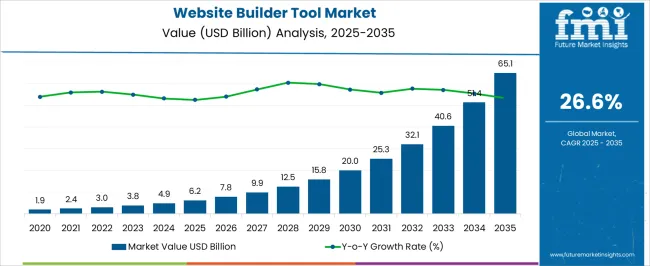
| Metric | Value |
|---|---|
| Website Builder Tool Market Estimated Value in (2025 E) | USD 6.2 billion |
| Website Builder Tool Market Forecast Value in (2035 F) | USD 65.1 billion |
| Forecast CAGR (2025 to 2035) | 26.6% |
The website builder tool market is expanding rapidly, supported by the rising digitalization of businesses and increasing demand for low-code and no-code solutions. Industry reports and company announcements have pointed to a surge in adoption among small and medium-sized enterprises seeking cost-effective platforms to establish their online presence.
Enhanced functionalities such as drag-and-drop interfaces, integrated SEO tools, and e-commerce modules have made website builder tools more versatile and accessible. In addition, technology companies have invested in cloud-based platforms, enabling seamless cross-device editing and real-time collaboration, which has broadened market adoption.
The market is further strengthened by the growing demand for personalized websites in both developed and emerging economies, where businesses and individuals prioritize professional online identities. Future growth is expected to be fueled by the integration of AI-driven design assistants, multi-language support, and advanced analytics, which will expand the usability of website builder tools across diverse industries. Segmental expansion is being led by PC website builders, which continue to dominate usage, and business website applications, which form the largest share of end-user demand.
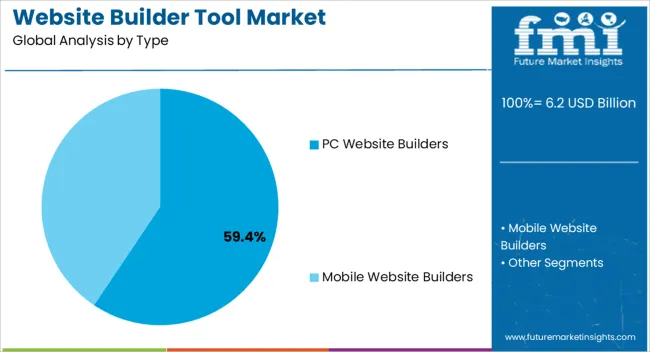
The PC Website Builders segment is projected to account for 59.40% of the website builder tool market revenue in 2025, maintaining its leadership among platform types. This dominance has been shaped by the widespread use of desktop-based solutions, which provide stability, broader design capabilities, and compatibility with professional workflows.
Developers and business owners have continued to prefer PC platforms for building complex websites that require advanced customization and integration with third-party software. PC-based tools also offer greater screen real estate and processing capacity, which enhance the design process compared to mobile-based solutions.
Industry updates have highlighted ongoing product enhancements in PC website builders, including advanced e-commerce modules, CRM integrations, and marketing automation features, reinforcing their value proposition. With a large proportion of businesses still relying on desktop environments for operations, the PC Website Builders segment is expected to sustain its strong position in the market.
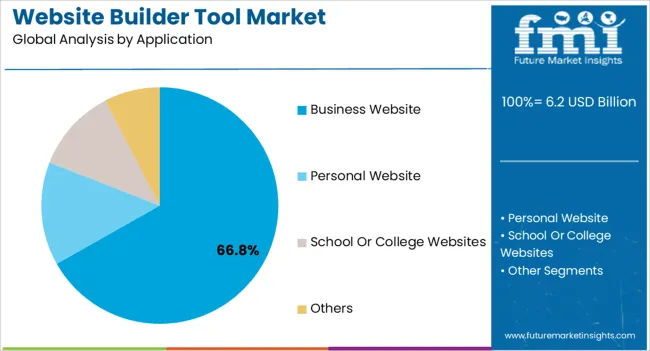
The Business Website segment is projected to contribute 66.80% of the website builder tool market revenue in 2025, making it the leading application area. Growth of this segment has been driven by the rising importance of digital presence for enterprises of all sizes, as business websites have become essential for brand identity, customer engagement, and sales.
Industry publications and corporate disclosures have emphasized that businesses are prioritizing scalable, customizable, and secure website solutions to meet customer expectations in competitive markets. Website builder platforms have responded by introducing tailored features such as integrated payment gateways, appointment scheduling, and marketing analytics to support business growth.
Additionally, the shift toward e-commerce and digital services has accelerated the demand for reliable business websites, further boosting this segment. As enterprises continue to invest in strengthening their online visibility and enhancing customer experience, the Business Website segment is expected to retain its leading position in the website builder tool market.
Market players are banking on technological advancements surging better user interfaces by introducing new frameworks, design trends, and mobile app developments to satisfy huge consumer demands and promote the best website builder tool market growth.
Machine learning and AI implementation to further improve user interface increases demand for website builder tools. Implementation of progressive web apps catering to various consumer demands further surges the sales of website builder tools.
Various features, including robust integration with a wide array of third-party services like calendars, Instagram feeds, and maps, increase the demand for website builder tools. Government compliance, investments, and requirements contribute to the global website builder tool market share.
North America leads the website builder tool market share with an approximate revenue of 38%. The early adoption of technology and its eventual advancements promise website builder tool market growth in this region.
Global technological advancement presents immense growth opportunities for website builder providers in this region. The presence of skillful website building vendors and providers benefits the website builder tool market size of this region.
The Asia Pacific is the second and fastest-growing region in website builder tool market share. This is owing to the rising number of start-ups and small businesses in the developing economies of this region.
Japan experiencing an increase in the adoption of cloud-based services from large enterprises as well as SMEs, driving the demand for website builder tool.
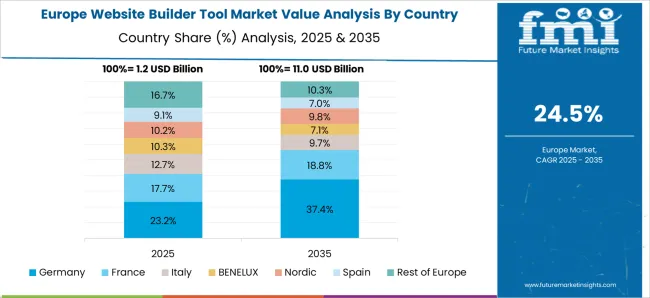
Europe projects a revenue share of 25% and is a growing website builder tool market. Owing to technological advancements and the presence of website builder providers in this region, the website builder tool market share experiences growth.
The increasing importance of having a strong online presence for businesses surges the website builder tool market growth by generating the demand for website builder tools. The cost-effective feature of these tools, including ease of use, propels the website builder tool market share.
The website builders market is divided into two types: PC website builders and mobile website builders, with the PC website builders sector accounting for the highest CAGR of 27.5% throughout the period of projection.
The growing demand for PC-based website issues around the world is expected to drive demand for PC website builders in the next years. Almost every company in the entire globe has a website, consequently website builders are providing unique PC website creation choices.
Communicating and marketing have become routine among people. The advent of technology offers newer and better services and products that increase engagement in both social media and e-commerce.
Several start-up companies are implementing useful strategies to reach their potential customers in the ecommerce website builder tool market share.
Renderforest, FRONTASTIC, Shogun, Universe, Strikingly, Webflow, etc. provide various adoption of website builder tools such as responsive websites with drag and drop features, pre-designed templates and platforms, creation of online business cards, API-first e-commerce and CMS platforms for businesses, slideshow, and animated video maker, etc.
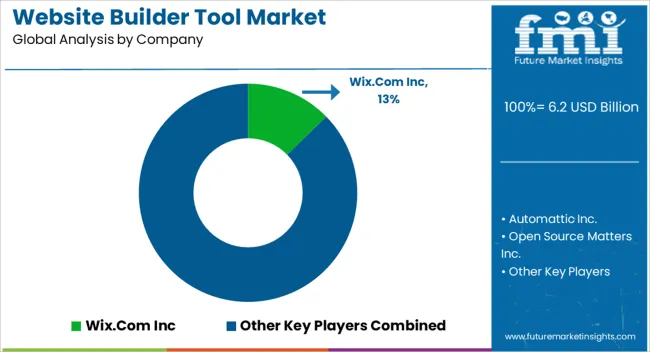
Some of the key market participants in the website builder tool market are Wix.com Inc., Automattic Inc., Open Source Matters Inc., Weebly, Inc., Webs, Duda and Doodlebit LLC, Yola Inc., IM CREATOR, SQUARESPACE, Sitey, JIMDO GmBH, WebStarts, GoDaddy, Mono Solutions, Shopify, Ecwid, Wordpress.Com, Basekit, Unbounce, Instapage, Webflow, The Endurance International Group Inc., Square Inc., WOW Slider, SITE123, Simbla Inc., Sitey, bluehost Inc., IM Creator Ltd., Homestead Technologies Inc., Zoho Corporation Pvt. Ltd., etc.
The ability to express one’s own brand in an inventive way to attract an audience is intriguing, as well as creating a website showcasing the product line, brand vision and goals, achievements, etc. Key website builder tool market players are utilizing this concept to develop different ecommerce website builder tool to attain these features.
Some of the recent developments in the website builder tool market are
| Report Attribute | Details |
|---|---|
| Growth Rate | CAGR of 26.6% from 2025 to 2035 |
| Website Builder Tool Market Size (2025) | USD 3,754.2 million |
| Website Builder Tool Market Size (2035) | USD 44,322.2 million |
| Base year for estimation | 2025 |
| Historical data | 2020 to 2025 |
| Forecast period | 2025 to 2035 |
| Quantitative units | Revenue in USD million and CAGR from 2025 to 2035 |
| Report Coverage | Revenue forecast, volume forecast, company ranking, competitive landscape, growth factors, and trends, Pricing Analysis |
| Segments Covered | Type, Application, Region |
| Regions Covered | North America; Latin America; Western Europe; Eastern Europe; South Asia & Pacific; East Asia; Middle East & Africa |
| Country scope | United States, Canada, Brazil, Mexico, Germany, United Kingdom, France, Spain, Italy, Poland, Russia, Czech Republic, Romania, India, Bangladesh, Australia, New Zealand, China, Japan, South Korea, GCC Countries, South Africa, Israel |
| Key companies profiled | Wix.com Inc.; Automattic Inc.; Open Source Matters Inc.; Weebly, Inc.; Webs; Duda and Doodlebit LLC; Yola Inc.; IM CREATOR; SQUARESPACE; Sitey; JIMDO GmBH; WebStarts; GoDaddy; Mono Solutions; Shopify; Ecwid; Wordpress.Com; Basekit; Unbounce; Instapage; Webflow; The Endurance International Group Inc.; Square Inc.; WOW Slider; SITE123; Simbla Inc.; Sitey; bluehost Inc.; IM Creator Ltd.; Homestead Technologies Inc.; Zoho Corporation Pvt. Ltd. |
| Customization & Pricing | Available upon Request |
The global website builder tool market is estimated to be valued at USD 6.2 billion in 2025.
The market size for the website builder tool market is projected to reach USD 65.1 billion by 2035.
The website builder tool market is expected to grow at a 26.6% CAGR between 2025 and 2035.
The key product types in website builder tool market are pc website builders and mobile website builders.
In terms of application, business website segment to command 66.8% share in the website builder tool market in 2025.






Our Research Products

The "Full Research Suite" delivers actionable market intel, deep dives on markets or technologies, so clients act faster, cut risk, and unlock growth.

The Leaderboard benchmarks and ranks top vendors, classifying them as Established Leaders, Leading Challengers, or Disruptors & Challengers.

Locates where complements amplify value and substitutes erode it, forecasting net impact by horizon

We deliver granular, decision-grade intel: market sizing, 5-year forecasts, pricing, adoption, usage, revenue, and operational KPIs—plus competitor tracking, regulation, and value chains—across 60 countries broadly.

Spot the shifts before they hit your P&L. We track inflection points, adoption curves, pricing moves, and ecosystem plays to show where demand is heading, why it is changing, and what to do next across high-growth markets and disruptive tech

Real-time reads of user behavior. We track shifting priorities, perceptions of today’s and next-gen services, and provider experience, then pace how fast tech moves from trial to adoption, blending buyer, consumer, and channel inputs with social signals (#WhySwitch, #UX).

Partner with our analyst team to build a custom report designed around your business priorities. From analysing market trends to assessing competitors or crafting bespoke datasets, we tailor insights to your needs.
Supplier Intelligence
Discovery & Profiling
Capacity & Footprint
Performance & Risk
Compliance & Governance
Commercial Readiness
Who Supplies Whom
Scorecards & Shortlists
Playbooks & Docs
Category Intelligence
Definition & Scope
Demand & Use Cases
Cost Drivers
Market Structure
Supply Chain Map
Trade & Policy
Operating Norms
Deliverables
Buyer Intelligence
Account Basics
Spend & Scope
Procurement Model
Vendor Requirements
Terms & Policies
Entry Strategy
Pain Points & Triggers
Outputs
Pricing Analysis
Benchmarks
Trends
Should-Cost
Indexation
Landed Cost
Commercial Terms
Deliverables
Brand Analysis
Positioning & Value Prop
Share & Presence
Customer Evidence
Go-to-Market
Digital & Reputation
Compliance & Trust
KPIs & Gaps
Outputs
Full Research Suite comprises of:
Market outlook & trends analysis
Interviews & case studies
Strategic recommendations
Vendor profiles & capabilities analysis
5-year forecasts
8 regions and 60+ country-level data splits
Market segment data splits
12 months of continuous data updates
DELIVERED AS:
PDF EXCEL ONLINE
Tool Holders Market Size and Share Forecast Outlook 2025 to 2035
Tool Box Market Size and Share Forecast Outlook 2025 to 2035
Tool Tethering Market Size and Share Forecast Outlook 2025 to 2035
Tool Steel Market Size and Share Forecast Outlook 2025 to 2035
Tool Presetter Market Trend Analysis Based on Product, Category, End-Use, and Region 2025 to 2035
Understanding Market Share Trends in the Tool Box Industry
Tool Holder Collets Market
Tool Chest Market
Stool Management System Market Analysis - Size, Share, and Forecast Outlook 2025 to 2035
AI Builder Market - Growth, Demand & Forecast 2025 to 2035
CNC Tool Storage System Market
Brow Tools Market Size and Share Forecast Outlook 2025 to 2035
Hand Tools Market Size and Share Forecast Outlook 2025 to 2035
Key Players in the Hand Tools Market Share Analysis
Power Tools Market Size and Share Forecast Outlook 2025 to 2035
Smart Tools Market Size and Share Forecast Outlook 2025 to 2035
Power Tools Industry Analysis in India - Size, Share, and Forecast Outlook 2025 to 2035
Power Tool Gears Market - Growth & Demand 2025 to 2035
Baking Tools Market Size and Share Forecast Outlook 2025 to 2035
Rotary Tool Market Size and Share Forecast Outlook 2025 to 2035

Thank you!
You will receive an email from our Business Development Manager. Please be sure to check your SPAM/JUNK folder too.
Chat With
MaRIA